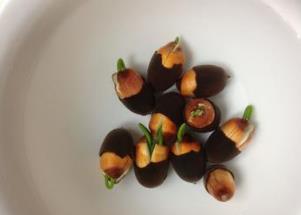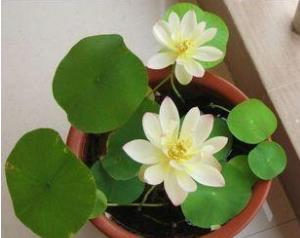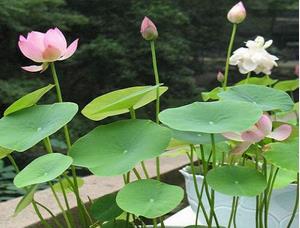Matters needing attention in planting methods of bowl lotus
Bowl lotus is also a kind of lotus, which is suitable for family planting, but how much do you know about bowl lotus? now let me introduce you the planting knowledge of bowl lotus.
First, the planting method of bowl lotus

The first step is to break the shell of the seed, the pericarp of lotus seed has a strong and thick special structure, after the seed is fully mature and dry, the water and air are not easy to penetrate, the respiration is very slow, and is forced to dormancy. So lotus seeds can be buried in the soil for hundreds or even thousands of years without germination or decay, which is the reason for the longevity of lotus seeds. In order to make the lotus seeds absorb water and oxygen after sowing, break the forced dormancy and enter into germination and growth, the seeds must be treated with shell breaking before germination.
Lotus is an anatropous ovule, and the germ is born at the top of the seed. When breaking the shell, the base end of the seed should be broken, that is, the end where the seed is placed on the receptacle, that is, the sunken end of the lotus seed. It can be broken with scissors or pliers. Generally speaking, before sowing, as long as the pericarp (that is, the hard shell of the lotus seed) is worn, the brown seed coat is seen; when the shell is clamped, there is only a 2mm crack at the base, do not clip it too deep, so as to avoid damaging the embryo. After one day of seed soaking, when the embryo expands and the pericarp becomes soft, the peel can be peeled off by hand along the broken shell to expose the embryo to facilitate the elongation of the germ. It must be noted that the broken shell should not be too large. If the hard shell of the lotus seed is removed, the germ will lose its protection and rot easily.

The second step is to soak the seeds to accelerate germination and soak the broken seeds in warm water of about 50 degrees. The water of soaking seeds should be clean, free of grease and dirt, and do not use water higher than 50 degrees, otherwise it will affect germination. The water temperature drops naturally and is kept at about 30 degrees at last, not higher than 40 degrees or less than 20 degrees. If the water temperature is higher than 40 degrees, the seeds germinate rapidly on the first day, but the growth is inhibited later. when the water temperature is lower than 20 degrees, the seeds germinate and grow too slowly. When soaking a small amount of seeds in the family, it can be put into a thermos to keep warm. Under the condition of temperature of 30 degrees, generally soaking seeds to accelerate germination for 3 days, the germ protrudes from the break. During this period, the water needs to be changed one or three times a day, and the seeds that cannot germinate should be removed in time. Under normal circumstances, seeds that have not germinated for seven days will no longer germinate. Seeds that do not have the ability to germinate tend to float on the water, the germ is yellow, and the cotyledons are moldy and smelly.

In the third step, the seeds were cultured in water. After the seeds emerged, the seedlings should be raised in water for 5-7 days under the condition of about 25 ℃. During the period of hydroponic cultivation, the root absorption of lotus seedlings is weak, and their growth mainly depends on seed embryos to provide nutrients, and generally does not need fertilization. In the process of hydroponic cultivation, the depth of the water layer should be kept at about 10 meters, and sufficient light should be given; the water should not be changed or turned frequently to avoid excessive elongation of the leaves due to the frequent change of their growth direction; the petiole should be kept in the water and the leaves spread freely on the surface of the water. When the first leaf is released and the second leaf is about to release and grow white roots, it can be planted.

The fourth step is to plant. When the buds grow to 10CM or so, they can be transplanted. According to the needs of bowl lotus planting, choose the soil into the flower bowl, put in the water, and mix the soil and fertilizer evenly. After the muddy water is clarified, the water-cultured seedlings are planted in the center of the flower bowl, with all the seeds in the mud, so that the leaves can stretch freely on the surface of the water. When transplanting, it should be noted that the petiole should not be broken so as not to affect the growth. Keep 3-5 cm water layer after planting, but never submerge the leaves in the water. The bowl of lotus likes the light, and the flower bowl should be placed in a place with plenty of sunshine. The seedlings are delicate and some will scorch when the sun burns, but they will generally sprout and survive. Don't water too much to raise the temperature of the water and promote growth. Standing leaves can appear after 7-13 floating leaves are grown. Generally speaking, multi-flowered varieties can appear buds after growing 5-17 standing leaves. The bud appears sooner or later, depending on the variety, and some varieties bloom before the standing leaves grow.

Second, the maintenance methods of bowl lotus in summer.
After the Beginning of Summer, watering the bowl once a day can make the lotus grow normally. In July and August, water is irrigated to ensure continuous water every day, so it is irrigated twice a day, otherwise the standing leaves wilt until dry green. When there are duckweed, field duckweed, floating moss and green algae in the basin, it not only takes fertilizer, but also hinders viewing, and shading to reduce water temperature, should be removed clean. In addition, the breeding of aquatic plants should be carefully removed. Immediately remove the burn as soon as the rot and brown spot of the lotus appear, and then spray more than 50% carbendazim or Phytophthora 500 times, once a week, about three times in a row.
Third, matters needing attention when planting

Bowl lotus is propagated with lotus seeds or lotus roots. To propagate with seeds, we should first break the shell of lotus seeds with pliers, pay attention not to hurt the germ, and then soak the seeds in warm water of about 50 ℃. After the natural cooling, keep the water temperature of about 28 ℃. Change the water once or twice a day, after about 5 to 7 days, it can sprout and wait for rooting before planting. The cultivation container should be suitable, too big and indecent, too small and too shallow, then the root system does not grow well, it is not easy to bloom well, or the flowers are few and small. Cultivated soil, you can choose fertile lakes, pond mud, mixed with a small amount of mature human feces and urine or cake fertilizer water, can meet the needs of annual growth. If the amount of fertilizer is too large, light leaves and flowers sparse, heavy lotus root will die. If the water in the basin turns green and black, and the lotus leaves wrinkle and do not spread, it is a symbol of fertilizer damage. You should immediately pour out all the fat and water in the basin and relieve it with clean water continuously. When applying liquid topdressing during the growing period of large seedlings, do not defile the leaves and buds, so as to avoid rotten leaves and flowers. The fruit of the bowl lotus should vary from time to time, the small seedling stage should be shallow water, with the growth of floating leaves, gradually raise the water surface, after the standing leaves stand out, the basin can be filled with water, about 6 meters thick. Water frequently in summer, if the water is lost, the leaves will soon scorch the edge, when the temperature is not high, one watering should not be too much, too much water, then the water temperature, mud temperature decreases, affecting plant growth and development, serious, the lotus root will mildew and die. The bowl lotus likes the sun, so you should put the flowerpot in a sunny place. If the light is not enough, the lotus leaves will grow and the green will fade, so that they will not be able to blossom. Although the bowl lotus is hardy, the lotus root is delicate and the container is small. At low temperature, the lotus root is easy to suffer frost damage. Therefore, watering is not allowed in winter, as long as the basin mud is kept dry. Before and after the Qingming Festival, turn over the basin to take the lotus root, do not hurt the top bud, change the new soil and replant. If cultivated and managed properly, a bowl of lotus can bloom 5 to 6 flowers a year, with a florescence of up to a month, placed on the window desk, with bright colors, pleasant fragrance and elegant demeanour.
Second, the maintenance methods of bowl lotus in summer.
After the Beginning of Summer, watering the bowl once a day can make the lotus grow normally. In July and August, water is irrigated to ensure continuous water every day, so it is irrigated twice a day, otherwise the standing leaves wilt until dry green. When there are duckweed, field duckweed, floating moss and green algae in the basin, it not only takes fertilizer, but also hinders viewing, and shading to reduce water temperature, should be removed clean. In addition, the breeding of aquatic plants should be carefully removed. Immediately remove the burn as soon as the rot and brown spot of the lotus appear, and then spray more than 50% carbendazim or Phytophthora 500 times, once a week, about three times in a row.
Third, matters needing attention when planting

Bowl lotus is propagated with lotus seeds or lotus roots. To propagate with seeds, we should first break the shell of lotus seeds with pliers, pay attention not to hurt the germ, and then soak the seeds in warm water of about 50 ℃. After the natural cooling, keep the water temperature of about 28 ℃. Change the water once or twice a day, after about 5 to 7 days, it can sprout and wait for rooting before planting. The cultivation container should be suitable, too big and indecent, too small and too shallow, then the root system does not grow well, it is not easy to bloom well, or the flowers are few and small. Cultivated soil, you can choose fertile lakes, pond mud, mixed with a small amount of mature human feces and urine or cake fertilizer water, can meet the needs of annual growth. If the amount of fertilizer is too large, light leaves and flowers sparse, heavy lotus root will die. If the water in the basin turns green and black, and the lotus leaves wrinkle and do not spread, it is a symbol of fertilizer damage. You should immediately pour out all the fat and water in the basin and relieve it with clean water continuously. When applying liquid topdressing during the growing period of large seedlings, do not defile the leaves and buds, so as to avoid rotten leaves and flowers. The fruit of the bowl lotus should vary from time to time, the small seedling stage should be shallow water, with the growth of floating leaves, gradually raise the water surface, after the standing leaves stand out, the basin can be filled with water, about 6 meters thick. Water frequently in summer, if the water is lost, the leaves will soon scorch the edge, when the temperature is not high, one watering should not be too much, too much water, then the water temperature, mud temperature decreases, affecting plant growth and development, serious, the lotus root will mildew and die. The bowl lotus likes the sun, so you should put the flowerpot in a sunny place. If the light is not enough, the lotus leaves will grow and the green will fade, so that they will not be able to blossom. Although the bowl lotus is hardy, the lotus root is delicate and the container is small. At low temperature, the lotus root is easy to suffer frost damage. Therefore, watering is not allowed in winter, as long as the basin mud is kept dry. Before and after the Qingming Festival, turn over the basin to take the lotus root, do not hurt the top bud, change the new soil and replant. If cultivated and managed properly, a bowl of lotus can bloom 5 to 6 flowers a year, with a florescence of up to a month, placed on the window desk, with bright colors, pleasant fragrance and elegant demeanour.
Related
- Wuhan Hospital Iron Tree Blooming Result Was Instantly Frightened by the Gardener Master
- Which variety of camellia is the most fragrant and best? Which one do you like best?
- What is the small blue coat, the breeding methods and matters needing attention of the succulent plant
- Dormancy time and maintenance management of succulent plants during dormancy
- Minas succulent how to raise, Minas succulent plant pictures
- What are the varieties of winter succulent plants
- How to raise succulent plants in twelve rolls? let's take a look at some experience of breeding twelve rolls.
- Attention should be paid to water control for succulent plants during dormant period (winter and summer)
- Watering experience of twelve rolls of succulent plants
- Techniques for fertilizing succulent plants. An article will let you know how to fertilize succulent plants.



